Content
- What is sinus rhythm on an ECG?
- Norms of sinus rhythm in women by age, during pregnancy
- ECG decoding algorithm
- Heart rate
- Regularity of rhythm
- Conductivity
- Electric axle
- Types of violations and their characteristics on the ECG
- Excessive regularity of rhythm
- Tachycardia
- Slowing sinus rhythm
- Sinus arrhythmia
- Extrasystole
- Sick sinus syndrome
- What signs should you pay attention to?
- Causes of deviations and their treatment
- Sinus tachycardia
- Sinus bradycardia
- Sinus arrhythmia
- Forecasts
- Sinus Rhythm Videos
Sinus rhythm provides full electrical conduction in the heart. Each age has its own characteristic differences and norms of sinus conduction. At the same time, the indicators for women differ from male rhythms.
The sinus node is the plexus that supplies the atria and ventricles with impulses that cause the heart to contract and function normally. Sinus rhythm on the electrocardiogram (ECG) allows you to determine the heart rate (HR), the number of outgoing and generated impulses outgoing from the sinus node.
Norms of sinus rhythm in women by age, during pregnancy
In women, depending on age, sinus rhythm can change, especially during pregnancy.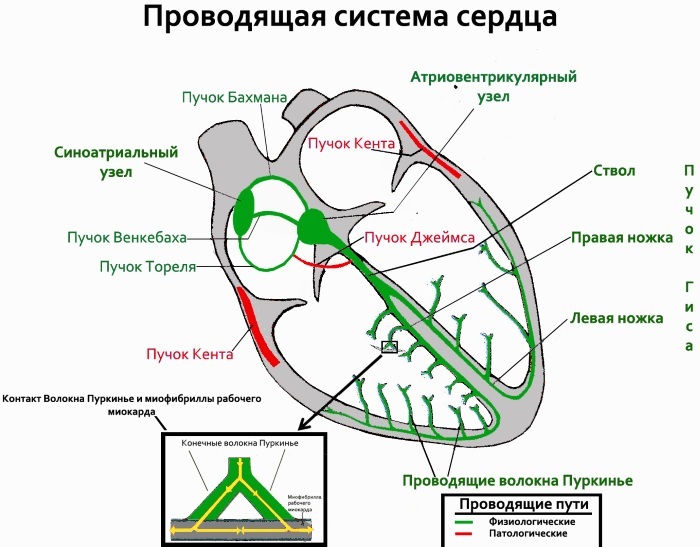
| Age | Norm |
| under 18 years old | 60-90 blows min. |
| from 18 to 30 years old | 75-90 strokes per minute. |
| from 35 to 50 years old | from 60 to 85 strokes per minute. |
| from 50 to 65 years old | 70-75 strokes per minute. |
| over 65 years old | 60-80 strokes per minute. |
During pregnancy, the norm is between 30 and 70 beats per minute. Values from 70 to 90 beats are also not pathological. By the third trimester, the heart rate can reach 110 beats in 1 minute.
ECG decoding algorithm
Deciphering the study should be done by a qualified specialist. At the same time, there is a certain regulation and algorithm that will allow you to accurately determine the presence of deviations and establish a diagnosis.
Heart rate
First of all, the heart rate is determined. To do this, it is necessary to count the number of intervals in the R-R waves taken in 3 s. Then the resulting amount is multiplied by 20.
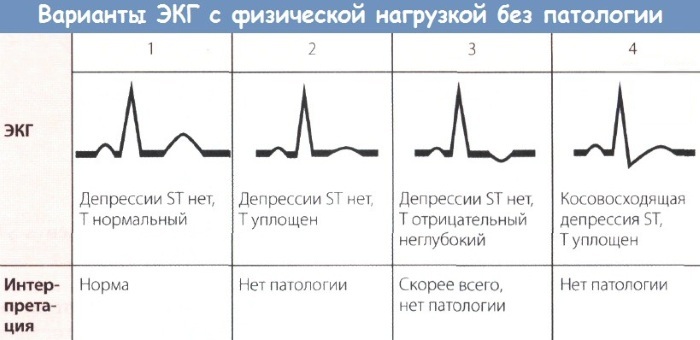
Rhythms from 60 to 80 beats per minute are considered normal indicators.
Regularity of rhythm
To determine if the heart rate is correct, it is necessary to compare the duration of the R-R intervals. In this case, the maximum discrepancy between them should not exceed 0.1 s. With the same indicators in the interval leads, there are risks of developing weakness of the sinus node. With changes in regularity up or down, various disorders in the myocardium may occur.
Conductivity
Conduction is responsible for the impulse transmission process. Normal indicators are considered when impulses are transmitted alternately in a strict sequence from one pacemaker to another. The sources of excitation are various conducting systems - the His bundle, as well as the SA and AV nodes.
In case of violation of the conductivity of these systems, a blockade occurs, which is divided into 3 main types:
- Intra-atrial. This type of deflection is characterized by a prolonged P wave.
- Sinus. This violation causes PQRST cycles to drop out periodically. The R-R spacing increases significantly.
- Atrioventricular. This blockade is of 3 degrees. This changes the PQRST system.
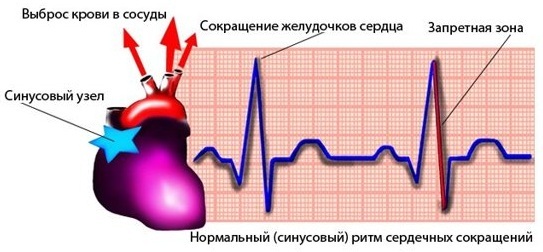
A competent transcript will allow you to accurately establish the type and type of violation.
Electric axle
Sinus rhythm (the norm in women by age is determined according to the table presented in the article) also depends on the electrical axis.
This characteristic is determined by the excitation of the ventricles. To decipher the diagnosis, it is necessary to take into account the position of the QRS in 2 leads - aVL and aVF.
Violations in these indicators can be both the cause of the incipient pathology and develop due to an increase in the size of the left ventricle.
The electric axis shifts to the left for the following reasons:
- ischemic heart disease;
- disturbances in the functioning of the left ventricular valve;
- chronic high blood pressure.
When changing the electrical axis to the right side, the following violations may occur:
- asthma;
- bronchitis;
- Congenital heart defect;
- lesion with stenosis of the pulmonary artery.
In more rare cases, deviation of the axis to the right may indicate a violation of the tricuspid valve.
Types of violations and their characteristics on the ECG
Sinus rhythm (the norm in women by age may slightly change up or down) can lead to the development of various disorders in the work of the heart and heart muscle.
It is possible to determine this or that type of failure after a complete decoding of the ECG. Moreover, each pathology has its own distinctive features, which can be determined by a specialist by decoding the cardiogram.
Excessive regularity of rhythm
This violation leads to the fact that the heart becomes immune to external influences. Normal readings are when the heart rate rises during exercise and decreases at night.
This violation cannot always be detected using an ECG, therefore, additional studies in the form of daily mounting or bicycle ergometry may be prescribed.
Pathology is conditionally dangerous and can lead to insufficient blood supply to organs and tissues, as well as cause hypoxia.
Tachycardia
With sinus tachycardia, the indicators remain within normal limits. However, the heart rate can increase significantly up to 100 or more beats per minute.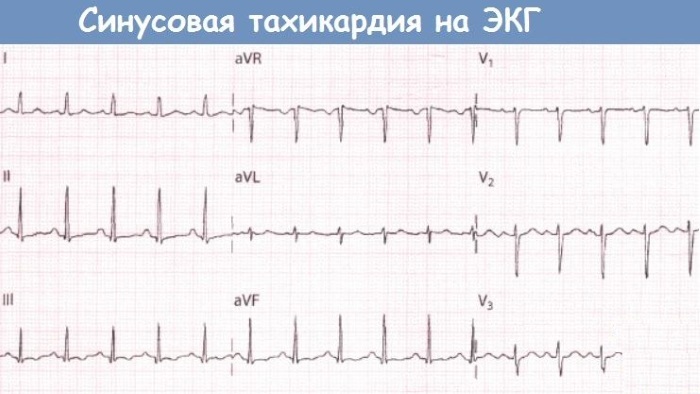
With pronounced signs of the disease, the following changes on the ECG may be observed:
- reduction of the P-R gap;
- an increase in the amplitude of P in I, II, aVF;
- increase or decrease in the amplitude of the T wave;
- slight change in the ST segment.
Sinus tachycardia is not a hazardous condition, however, in some cases it can be a sign of other disorders.
Slowing sinus rhythm
Pathology is one of the variants of bradycardia and is characterized by a decrease in the number of heart rate less than 60 beats per minute.
Symptoms of the disease appear only in the first stages of its development. In the future, the signs become less pronounced and noticeable for the patient himself. In this regard, at the first suspicion of bradycardia, you should immediately consult a doctor.
Sinus arrhythmia
Pathology combines a whole group of diseases in which the sinus rhythm is preserved, however, individual shocks can be skipped. The disorder has severe symptoms, accompanied by chest compression, fear and panic attacks, which are associated with a feeling that the heart may stop.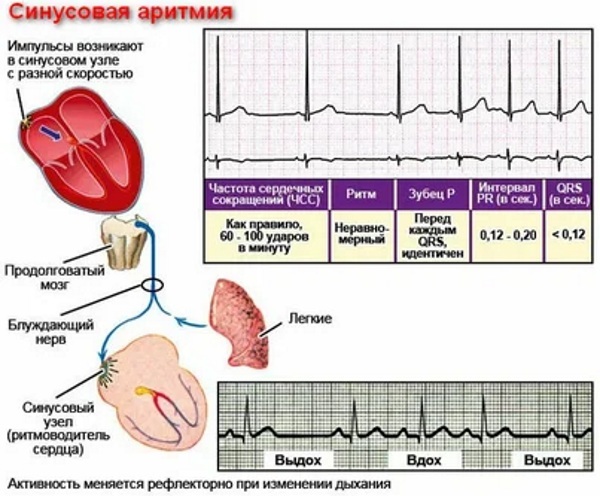
Pathology is characterized by different P-P intervals. In this case, the gap between the largest and smallest intervals is more than 0.12.
Extrasystole
This deviation is completely opposed to sinus arrhythmia and is characterized by extraordinary contractions of the myocardium at certain intervals.
With short episodic manifestations, the disease does not pose a danger to the health and life of the patient. However, in severe cases, pathologies can lead to cardiac arrest and, as a result, death.
ECG signs:
- early appearance of the P wave with deforming structural changes;
- extensive QRS complex;
- pairwise development of peaks.
In case of illness, additional electrocardiography is required.
Sick sinus syndrome
Sinus rhythm can be disrupted due to the weakness of the sinus node. This pathology does not depend on the woman's age and has complex symptoms. At the same time, the heart rate rate is significantly reduced.
Signs:
- reduced heart rate - 50 or less beats per minute;
- arrhythmia symptoms - passing beats;
- periodic signs of tachycardia.
This symptomatology lasts for 20-30 minutes. In more severe cases, the duration of the manifestations may increase.
Typical ECG symptoms:
- complete absence of P waves;
- disappearance or untimely occurrence of the QRS complex;
- deforming changes in peaks;
- signs of extrasystole, characterized by extraordinary contractions of the myocardium;
- symptoms of bradycardia.
In this case, secondary signs of the disease may develop, which may overlap.
What signs should you pay attention to?
At the first stages of the development of pathology, the patient experiences an acceleration or deceleration of the heart rate. With the further development of the disorder, the clinical picture does not have a clear severity.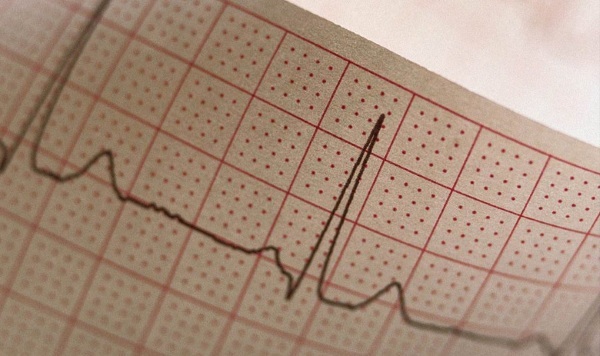
What you should pay attention to:
- Pain in the chest. The intensity of pain can vary. However, in some cases, they may not be present at all. With severe pain, the symptom indicates a poor supply of blood to the heart muscle. The nature of the pain - pressing, burning, bursting.
- Increased body sweating. It develops due to a decrease in heart rate and a decrease in blood pressure.
- Fatigue. The symptom may appear unexpectedly. It is associated with insufficient blood flow to the brain.
- Dyspnea. It can be either pronounced or practically invisible to the patient. This symptom develops gradually - first against the background of physical activity, then at rest or lying down.
- Neurological disorders, including headaches. Most often, pain occurs in the temporal or occipital region of the head. Paresis, impaired coordination of movements may also develop.
- Blanching of the skin and mucous membranes. Sometimes pallor can occur in the area of the nail plates. The skin becomes marbled with translucent vessels.
- Blue skin in the upper and lower extremities, as well as in the area of the nasolabial fold.
- Swelling. In the early stages of the disease, edema occurs only in the region of the extremities. As the pathology progresses, edema develops throughout the body.
- Sleep disturbance. Patients often have insomnia, which increases fatigue.
- Mental disorders associated with insufficient blood supply to the brain - psychosis, stress, depressive conditions.
With these signs, it is recommended to immediately contact a specialist.
Causes of deviations and their treatment
Sinus rhythm (the norm in women by age is established by the World Health Organization) can be disrupted against the background of many different factors, both external and internal.
At the moment, several reasons have been identified for the development of pathologies. For each case, its own methods of treatment and groups of drugs are prescribed.
Sinus tachycardia
In most cases, the disease develops against the background of other internal disorders, therefore, it is inherently symptomatic.
Causes:
- psychoemotional disorders and disorders;
- high physical activity;
- heart disease - organ failure, myocardial inflammation, congenital defects;
- anemic diseases;
- feverish conditions;
- infectious pathologies;
- abuse of coffee, energy drinks;
- smoking and alcohol;
- excessive use of drugs - antihypertensive drugs, asthma drugs, vasoconstrictor drops;
- endocrine pathologies - neoplasms in the adrenal glands (pheochromocytoma), thyrotoxicosis, disruptions in the production of hormones, diabetes insipidus.
Therapy is selected based on the cause that provoked the development of the disease, as well as on the basis of the severity of the pathological process.
Thus, in the neurotic form of the disease, antidepressants and sedatives are prescribed.
If you do not have enough fluid, it is recommended to take a fluid retention medication. Beta-blockers, cardiac glycosides, antiarrhythmics can also be prescribed. In severe cases, surgery is indicated, followed by the installation of a pacemaker.
Sinus bradycardia
In most cases, the disease is diagnosed in children and pregnant women.
Main reasons:
- cardiovascular disorders - heart failure, ischemic diseases, heart defects (congenital or acquired), a previous heart attack, cardiomyopathy;
- disruptions in metabolic processes;
- damage to the body by toxic substances;
- abuse of certain drugs;
- excessive excitability of the autonomic nervous system.
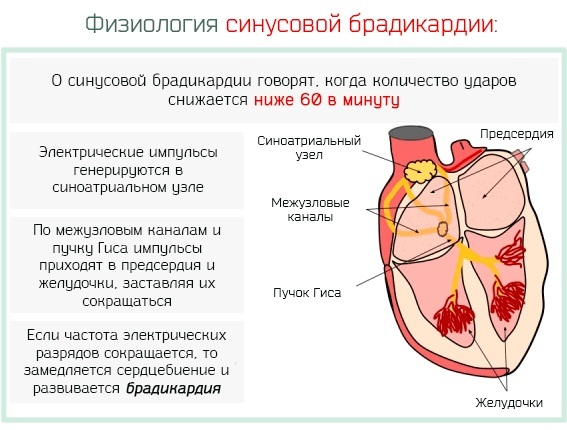 With a pronounced clinical picture, various drugs are prescribed. In this case, treatment is carried out only under the supervision of a specialist and depends on what exactly caused the development of the disorder.
With a pronounced clinical picture, various drugs are prescribed. In this case, treatment is carried out only under the supervision of a specialist and depends on what exactly caused the development of the disorder.
To eliminate symptoms, drugs such as Atropine (intravenously), Isoproterenol (intravenously), Alupent (infusion) can be used. They can also be prescribed for self-administration of tincture of Eleutherococcus or ginseng. As a supplement, preparations containing belladonna extract can be prescribed.
Therapy:
- In case of toxic damage, measures are taken to remove harmful substances from the body.
- For diseases of the thyroid gland, substitution therapy with levothyroxine is prescribed.
- For hyperkalemia, diuretics are used.
- In case of drug intoxication, the dosage of the medications taken should be reduced.
Additionally, it is necessary to exclude all provoking factors (alcohol, smoking) and adhere to the diet prescribed by the doctor.
Sinus arrhythmia
Sinus rhythm (the norm in women by age also depends on individual physiological characteristics) can go astray against the background of disturbances in the work of the myocardium. However, there are other factors that contribute to the development of the disease.
Causes:
- lack of magnesium or potassium in the body;
- dystonia (neurocircular form);
- the presence of osteochondrosis;
- insufficient supply of oxygen to tissues;
- hypothermia of the body;
- violation of protein metabolism (amyloidosis);
- endocrine pathologies;
- hormonal disruptions;
- kidney and liver diseases;
- various diseases of the spine;
- high blood pressure;
- psycho-emotional disorders;
- high physical activity;
- anemic conditions;
- gene mutations (acidemia);
- infectious damage to the body.

Treatment is selected in connection with the cause that provoked its development.
Therapeutic activities:
- taking various groups of medicines;
- adherence to a diet rich in potassium and magnesium;
- balanced rest and activity, adherence to regimens;
- physiotherapy (without the use of electric current);
- surgical interventions - installation of a pacemaker.
With a prolonged and severe course of the disease, intravenous administration of Atropine is additionally prescribed. As a supplement with a deficiency of macro- and microelements, various vitamin complexes can be prescribed.
Forecasts
In most cases, the prognosis for full recovery is favorable. However, in congenital anomalies requiring immediate surgical intervention, the outcome for clinical cure depends on the promptness of action.
In the absence of qualified assistance, the risks of complications or death are significantly increase, therefore, if you suspect the development of pathology, you should immediately contact to the doctor.
As a prevention of the development of disorders associated with a violation of the norm of sinus rhythm, it is necessary to systematically (at least 2 times a year) undergo examinations by a specialist. This is especially true for elderly patients, as well as women during pregnancy.
Sinus Rhythm Videos
ECG - Normal Sinus Rhythm:
